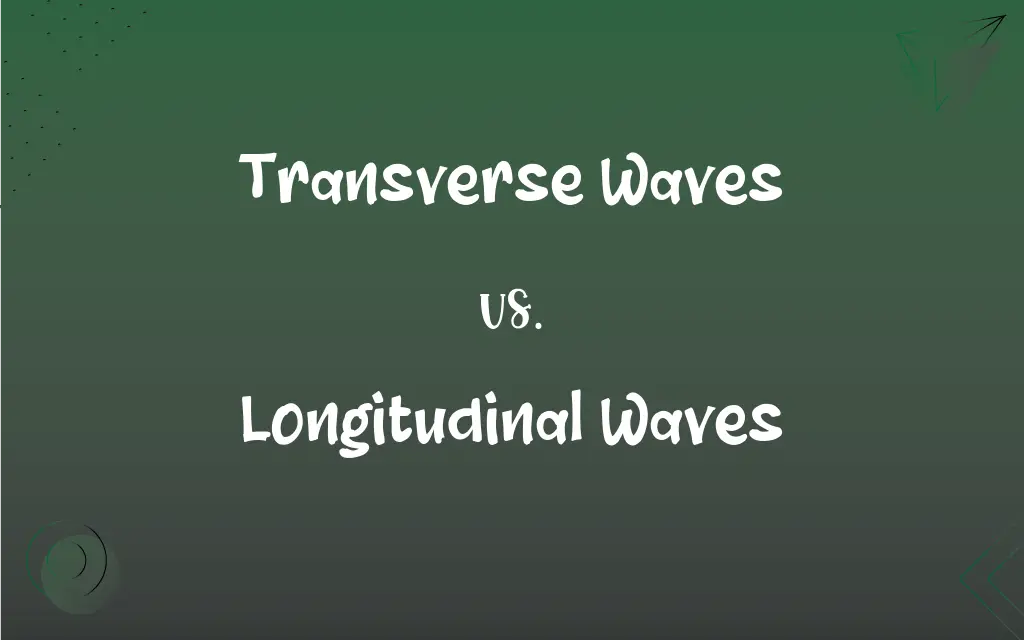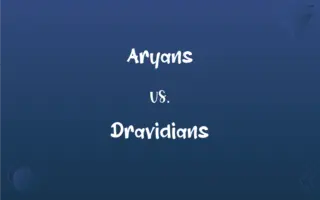Transverse Waves vs. Longitudinal Waves: What's the Difference?
Edited by Janet White || By Harlon Moss || Published on February 5, 2024
Transverse waves oscillate perpendicular to the direction of energy transfer, like light; longitudinal waves oscillate parallel, like sound in air.

Key Differences
In transverse waves, the particles of the medium oscillate perpendicular to the direction of wave propagation. This is visible in waves on a string or water surface. Longitudinal waves, however, have particles oscillating parallel to the direction of wave travel, as seen in sound waves traveling through air.
Transverse waves are exemplified by light waves and electromagnetic radiation, where the electric and magnetic fields oscillate perpendicularly to the direction of the wave. Longitudinal waves are commonly experienced as sound waves, where air particles compress and expand in the direction the wave is moving.
Transverse waves are characterized by peaks (crests) and troughs, with the wave amplitude measured from the central line to the crest or trough. In longitudinal waves, the amplitude is determined by the maximum compression or rarefaction of the medium, with regions called compressions and rarefactions instead of crests and troughs.
Transverse waves can travel through solids and are evident in surface waves on liquids, they cannot travel through gases. Longitudinal waves, conversely, can propagate through solids, liquids, and gases, making them more versatile in the mediums they can travel through.
Transverse waves are crucial in the field of optics and telecommunications due to the nature of electromagnetic waves. Longitudinal waves are vital in acoustics and seismology, where understanding sound waves and pressure waves in the Earth is essential.
ADVERTISEMENT
Comparison Chart
Direction of Oscillation
Perpendicular to wave direction
Parallel to wave direction
Natural Examples
Light waves, electromagnetic radiation
Sound waves, pressure waves
Characteristics
Peaks and troughs
Compressions and rarefactions
Medium of Propagation
Solids, surface of liquids
Solids, liquids, gases
Applications
Optics, telecommunications
Acoustics, seismology
ADVERTISEMENT
Transverse Waves and Longitudinal Waves Definitions
Transverse Waves
Used extensively in optics and communication technology.
Transverse waves play a crucial role in fiber optic cables.
Longitudinal Waves
Commonly experienced as sound waves in everyday life.
The music from the speakers propagated as longitudinal waves through the room.
Transverse Waves
Common in light and electromagnetic radiation.
Transverse waves are fundamental in understanding how light behaves.
Longitudinal Waves
Identified by compressions and rarefactions in the medium.
In longitudinal waves, the compressions and rarefactions create the sound we hear.
Transverse Waves
Waves where particles oscillate perpendicular to the wave direction.
The ripple in the pond was a perfect example of transverse waves.
Longitudinal Waves
Waves with particle oscillation parallel to the direction of travel.
Sound waves traveling through air are examples of longitudinal waves.
Transverse Waves
Characterized by peaks and troughs in their waveform.
He studied the peaks and troughs of transverse waves in his physics lab.
Longitudinal Waves
Crucial in the study of acoustics and seismology.
He used longitudinal waves to study earthquake vibrations.
Transverse Waves
Cannot travel through gases, only through solids and on liquid surfaces.
Transverse waves were observable on the string but not in the air.
Longitudinal Waves
Can propagate through solids, liquids, and gases.
Longitudinal waves are versatile, traveling through the ground as seismic waves.
FAQs
Can transverse waves travel through air?
No, transverse waves cannot travel through air but can through solids and on liquid surfaces.
What are longitudinal waves?
Longitudinal waves are waves where oscillations occur parallel to the direction of wave travel.
How do longitudinal waves travel through solids?
Longitudinal waves travel through solids via compressions and rarefactions of the material.
What is an example of a transverse wave?
Light waves are a common example of transverse waves.
How are transverse waves measured?
Transverse waves are measured by their amplitude and wavelength, from peak to peak or trough to trough.
What are transverse waves?
Transverse waves are waves where oscillations are perpendicular to the direction of energy transfer.
Do transverse waves require a medium?
Transverse waves require a medium like a solid or liquid surface but cannot travel through gases.
What is the speed of longitudinal waves?
The speed of longitudinal waves varies based on the medium, like sound speed in air.
How are longitudinal waves measured?
Longitudinal waves are measured by the distance between compressions or rarefactions.
What is the speed of transverse waves?
The speed of transverse waves depends on the medium, such as light speed in a vacuum.
How does temperature affect longitudinal waves?
Temperature can affect the speed of longitudinal waves, as it changes the properties of the medium.
What is polarization in transverse waves?
Polarization is a property of transverse waves, like light, where wave oscillations occur in a particular direction.
How are transverse waves used in communication?
Transverse waves, especially electromagnetic waves, are used in wireless communication.
What role do longitudinal waves play in medical imaging?
Longitudinal waves, such as ultrasound, are used in medical imaging to create images of internal body structures.
Can longitudinal waves travel through a vacuum?
No, longitudinal waves cannot travel through a vacuum as they require a medium.
What is an example of a longitudinal wave?
Sound waves in air are a typical example of longitudinal waves.
Are transverse waves affected by gravity?
Transverse waves like light can be affected by gravity in phenomena like gravitational lensing.
Can longitudinal waves interfere with each other?
Yes, like transverse waves, longitudinal waves can also exhibit interference patterns.
Can transverse waves interfere with each other?
Yes, transverse waves can interfere constructively or destructively.
Are longitudinal waves polarized?
No, longitudinal waves cannot be polarized due to their parallel oscillation direction.
About Author
Written by
Harlon MossHarlon is a seasoned quality moderator and accomplished content writer for Difference Wiki. An alumnus of the prestigious University of California, he earned his degree in Computer Science. Leveraging his academic background, Harlon brings a meticulous and informed perspective to his work, ensuring content accuracy and excellence.
Edited by
Janet WhiteJanet White has been an esteemed writer and blogger for Difference Wiki. Holding a Master's degree in Science and Medical Journalism from the prestigious Boston University, she has consistently demonstrated her expertise and passion for her field. When she's not immersed in her work, Janet relishes her time exercising, delving into a good book, and cherishing moments with friends and family.







































































